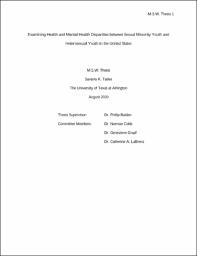| dc.description.abstract | Although various studies and systematic reviews have found an association between sexual orientation and health and mental health outcomes, few studies have examined a specific sample of adolescents aged 14 to 18 years of age that is generalizable to the entire United States population, while applying minority stress theory and general strain theory to a host of negative mental health outcomes and health risk behaviors in one study. The objective of this thesis is to examine a host of health and mental health outcomes among youth aged 14 to 18 years from a study generalizable to the entire United States population, while also applying minority stress theory and general strain theory, to find out whether sexual minority youth are at greater risk of experiencing poor health and mental health outcomes than their heterosexual peers. Controlling for age, sex, and race/ethnicity, this thesis examined a host of health and mental health outcomes among youth to find out whether sexual minority youth are at greater risk of experiencing poor health and mental health outcomes than their heterosexual peers. Data for this study came from the Centers for Disease Control and Prevention’s 2017 Youth Risk Behavior Survey (YRBS). A sample of 14,547 youth aged 14-18 years (50.1% female) was analyzed using weighted binary logistic regression to determine the association between sexual orientation and 24 dependent variables in the following categories: school safety and violent behaviors, victimization, mental health, suicidal behaviors, substance use, obesity, and protective factors. Of the 14,547 youth examined, 85.4% self-identified as heterosexual, 2.4% as lesbian/gay, 7.9% as bisexual, and 4.2% as unsure. Controlling for age, sex, and race/ethnicity, youth who self-identified as sexual minority (lesbian/gay, bisexual or unsure) were significantly more likely to engage in violent behaviors, be victimized, report poor mental health, engage in suicidal behaviors, engage in substance use, and be obese (adjusted odds ratios ranged from 1.42 to 6.38) compared to youth who self-identified as heterosexual. Youth who self-identified as sexual minority were significantly less likely to describe themselves as earning mostly A’s or B’s, played on a sports team, or were physically active (adjusted odds ratios ranged from 0.51 to 0.70) compared to youth who self-identified as heterosexual. The findings of this thesis extend past research on disparities of sexual minority youth and heterosexual youth in studies involving small samples or specific geographic locations that are not generalizable to the entire United States population, and this thesis uses these findings to explore implications for social work policy and practice. | |


